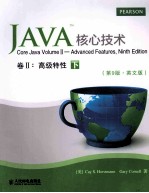图书介绍
JAVA核心技术 卷2 高级特性 下 第9版英文版【2025|PDF|Epub|mobi|kindle电子书版本百度云盘下载】

- (美)CAY S.HORSTMANN,GARY CORNELL著 著
- 出版社: 北京:人民邮电出版社
- ISBN:9787115319487
- 出版时间:2013
- 标注页数:1118页
- 文件大小:97MB
- 文件页数:579页
- 主题词:JAVA语言-程序设计-英文
PDF下载
下载说明
JAVA核心技术 卷2 高级特性 下 第9版英文版PDF格式电子书版下载
下载的文件为RAR压缩包。需要使用解压软件进行解压得到PDF格式图书。建议使用BT下载工具Free Download Manager进行下载,简称FDM(免费,没有广告,支持多平台)。本站资源全部打包为BT种子。所以需要使用专业的BT下载软件进行下载。如BitComet qBittorrent uTorrent等BT下载工具。迅雷目前由于本站不是热门资源。不推荐使用!后期资源热门了。安装了迅雷也可以迅雷进行下载!
(文件页数 要大于 标注页数,上中下等多册电子书除外)
注意:本站所有压缩包均有解压码: 点击下载压缩包解压工具
图书目录
Chapter 7:Advanced AWT549
7.1 The Rendering Pipeline550
7.2 Shapes553
7.2.1 Using the Shape Classes555
7.3 Areas570
7.4 Strokes572
7.5 Paint581
7.6 Coordinate Transformations583
7.7 Clipping589
7.8 Transparency and Composition592
7.9 Rendering Hints601
7.10 Readers and Writers for Images608
7.10.1 Obtaining Readers and Writers for Image File Types608
7.10.2 Reading and Writing Files with Multiple Images610
7.11 Image Manipulation619
7.11.1 Constructing Raster Images619
7.11.2 Filtering Images626
7.12 Printing636
7.12.1 Graphics Printing637
7.12.2 Multiple-Page Printing647
7.12.3 Print Preview649
7.12.4 Print Services659
7.12.5 Stream Print Services664
7.12.6 Printing Attributes664
7.13 The Clipboard672
7.13.1 Classes and Interfaces for Data Transfer674
7.13.2 Transferring Text674
7.13.3 The Transferable Interface and Data Flavors678
7.13.4 Building an Image Transferable680
7.13.5 Transferring Java Objects via the System Clipboard685
7.13.6 Using a Local Clipboard to Transfer Object References689
7.14 Drag and Drop689
7.14.1 Data Transfer Support in Swing691
7.14.2 Drag Sources696
7.14.3 Drop Targets699
7.15 Platform Integration707
7.15.1 Splash Screens708
7.15.2 Launching Desktop Applications713
7.15.3 The System Tray719
Chapter 8:JavaBeans Components725
8.1 Why Beans?726
8.2 The Bean-Writing Process728
8.3 Using Beans to Build an Application731
8.3.1 Packaging Beans in JAR Files731
8.3.2 Composing Beans in a Builder Environment733
8.4 Naming Patterns for Bean Properties and Events740
8.5 Bean Property Types743
8.5.1 Simple Properties744
8.5.2 Indexed Properties744
8.5.3 Bound Properties745
8.5.4 Constrained Properties746
8.6 BeanInfo Classes754
8.7 Property Editors758
8.7.1 Writing Property Editors762
8.7.1.1 String-Based Property Editors762
8.7.1.2 GUI-Based Property Editors765
8.8 Customizers770
8.8.1 Writing a Customizer Class772
8.9 JavaBeans Persistence779
8.9.1 Using JavaBeans Persistence for Arbitrary Data784
8.9.1.1 Writing a Persistence Delegate to Construct an Object784
8.9.1.2 Constructing an Object from Properties786
8.9.1.3 Constructing an Object with a Factory Method787
8.9.1.4 Postconstruction Work787
8.9.1.5 Transient Properties788
8.9.2 A Complete Example for JavaBeans Persistence791
Chapter 9:Security803
9.1 Class Loaders804
9.1.1 The Class Loader Hierarchy806
9.1.2 Using Class Loaders as Namespaces808
9.1.3 Writing Your Own Class Loader808
9.2 Bytecode Verification816
9.3 Security Managers and Permissions821
9.3.1 Java Platform Security822
9.3.2 Security Policy Files826
9.3.3 Custom Permissions834
9.3.4 Implementation of a Permission Class835
9.4 User Authentication842
9.4.1 JAAS Login Modules849
9.5 Digital Signatures858
9.5.1 Message Digests859
9.5.2 Message Signing862
9.5.3 Verifying a Signature865
9.5.4 The Authentication Problem868
9.5.5 Certificate Signing870
9.5.6 Certificate Requests872
9.6 Code Signing873
9.6.1 JAR File Signing873
9.6.2 Software Developer Certificates878
9.7 Encryption880
9.7.1 Symmetric Ciphers881
9.7.2 Key Generation882
9.7.3 Cipher Streams887
9.7.4 Public Key Ciphers888
Chapter 10:Scripting,Compiling,and Annotation Processing893
10.1 Scripting for the Java Platform894
10.1.1 Getting a Scripting Engine894
10.1.2 Script Evaluation and Bindings895
10.1.3 Redirecting Input and Output898
10.1.4 Calling Scripting Functions and Methods899
10.1.5 Compiling a Script901
10.1.6 An Example:Scripting GUI Events901
10.2 The Compiler API907
10.2.1 Compiling the Easy Way907
10.2.2 Using Compilation Tasks907
10.2.3 An Example:Dynamic Java Code Generation913
10.3 Using Annotations919
10.3.1 An Example:Annotating Event Handlers920
10.4 Annotation Syntax926
10.5 Standard Annotations931
10.5.1 Annotations for Compilation932
10.5.2 Annotations for Managing Resources932
10.5.3 Meta-Annotations933
10.6 Source-Level Annotation Processing935
10.7 Bytecode Engineering943
10.7.1 Modifying Bytecodes at Load Time949
Chapter 11:Distributed Objects953
11.1 The Roles of Client and Server954
11.2 Remote Method Calls957
11.2.1 Stubs and Parameter Marshalling957
11.3 The RMI Programming Model959
11.3.1 Interfaces and Implementations959
11.3.2 The RMI Registry961
11.3.3 Deploying the Program965
11.3.4 Logging RMI Activity968
11.4 Parameters and Return Values in Remote Methods970
11.4.1 Transferring Remote Objects971
11.4.2 Transferring Nonremote Objects971
11.4.3 Dynamic Class Loading974
11.4.4 Remote References with Multiple Interfaces979
11.4.5 Remote Objects and the equals,hashCode,and clone Methods980
11.5 Remote Object Activation980
Chapter 12:Native Methods989
12.1 Calling a C Function from a Java Program990
12.2 Numeric Parameters and Return Values997
12.2.1 Using printf for Formatting Numbers997
12.3 String Parameters999
12.4 Accessing Fields1005
12.4.1 Accessing Instance Fields1005
12.4.2 Accessing Static Fields1009
12.5 Encoding Signatures1010
12.6 Calling Java Methods1012
12.6.1 Instance Methods1012
12.6.2 Static Methods1016
12.6.3 Constructors1017
12.6.4 Alternative Method Invocations1018
12.7 Accessing Array Elements1019
12.8 Handling Errors1023
12.9 Using the Invocation API1028
12.10 A Complete Example:Accessing the Windows Registry1034
12.10.1 Overview of the Windows Registry1034
12.10.2 A Java Platform Interface for Accessing the Registry1036
12.10.3 Implementation of Registry Access Functions as Native Methods1036
Index1051
热门推荐
- 419679.html
- 3169727.html
- 1617637.html
- 2450569.html
- 1210691.html
- 1271606.html
- 292058.html
- 1850673.html
- 3572213.html
- 2838628.html
- http://www.ickdjs.cc/book_421276.html
- http://www.ickdjs.cc/book_3785907.html
- http://www.ickdjs.cc/book_3466391.html
- http://www.ickdjs.cc/book_3379359.html
- http://www.ickdjs.cc/book_2235754.html
- http://www.ickdjs.cc/book_2456957.html
- http://www.ickdjs.cc/book_1976964.html
- http://www.ickdjs.cc/book_1093084.html
- http://www.ickdjs.cc/book_3714402.html
- http://www.ickdjs.cc/book_2909316.html